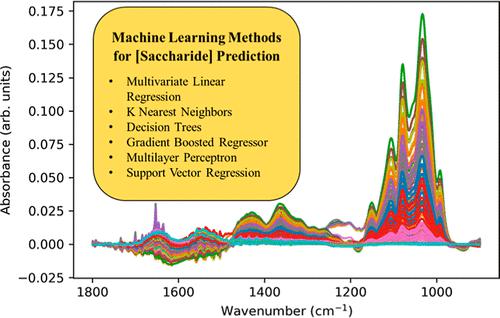当前位置:
X-MOL 学术
›
ACS Earth Space Chem.
›
论文详情
Our official English website, www.x-mol.net, welcomes your feedback! (Note: you will need to create a separate account there.)
Saccharide Concentration Prediction from Proxy Ocean Samples Analyzed Via Infrared Spectroscopy and Quantitative Machine Learning
ACS Earth and Space Chemistry ( IF 3.4 ) Pub Date : 2024-02-28 , DOI: 10.1021/acsearthspacechem.3c00310 Nicole M. North 1 , Abigail A. A. Enders 1 , Jessica B. Clark 1 , Kezia A. Duah 1 , Heather C. Allen 1
ACS Earth and Space Chemistry ( IF 3.4 ) Pub Date : 2024-02-28 , DOI: 10.1021/acsearthspacechem.3c00310 Nicole M. North 1 , Abigail A. A. Enders 1 , Jessica B. Clark 1 , Kezia A. Duah 1 , Heather C. Allen 1
Affiliation

|
Solvated organics in the ocean are present in relatively small concentrations but contribute largely to ocean chemical diversity and complexity. Existing in the ocean as dissolved organic carbon (DOC) and enriched within the sea surface microlayer (SSML), these compounds have large impacts on atmospheric chemistry through their contributions to cloud nucleation, ice formation, and other climatological processes. The ability to quantify the concentrations of organics in ocean samples is critical to understanding these marine processes. The work presented herein details an investigation to develop a machine learning (ML) methodology utilizing infrared spectroscopy data to accurately estimate saccharide concentrations in complex solutions. We evaluated multivariate linear regression (MLR), K-nearest neighbors (KNN), decision trees (DT), gradient-boosted regressors (GBR), multilayer perceptrons (MLP), and support vector regressors (SVR) toward this goal. SVR models are shown to best predict accurate generalized saccharide concentrations. Our work presents an application combining fast spectroscopic techniques with ML to analyze organic composition in proxy ocean samples. As a result, we target a generalized method for analyzing field marine samples more efficiently without sacrificing accuracy or precision.
中文翻译:

通过红外光谱和定量机器学习分析代理海洋样本的糖浓度预测
海洋中的溶剂化有机物浓度相对较低,但在很大程度上促进了海洋化学的多样性和复杂性。这些化合物以溶解有机碳 (DOC) 形式存在于海洋中,并在海面微层 (SSML) 中富集,通过促进云成核、冰形成和其他气候过程,对大气化学产生巨大影响。量化海洋样本中有机物浓度的能力对于了解这些海洋过程至关重要。本文介绍的工作详细介绍了一项研究,旨在开发一种利用红外光谱数据准确估计复杂溶液中糖浓度的机器学习 (ML) 方法。我们针对这一目标评估了多元线性回归 (MLR)、K 最近邻 (KNN)、决策树 (DT)、梯度增强回归器 (GBR)、多层感知器 (MLP) 和支持向量回归器 (SVR)。 SVR 模型被证明可以最好地预测准确的广义糖浓度。我们的工作提出了一种将快速光谱技术与机器学习相结合的应用程序,用于分析代理海洋样本中的有机成分。因此,我们的目标是一种更有效地分析现场海洋样本而不牺牲准确性或精密度的通用方法。
更新日期:2024-02-28
中文翻译:

通过红外光谱和定量机器学习分析代理海洋样本的糖浓度预测
海洋中的溶剂化有机物浓度相对较低,但在很大程度上促进了海洋化学的多样性和复杂性。这些化合物以溶解有机碳 (DOC) 形式存在于海洋中,并在海面微层 (SSML) 中富集,通过促进云成核、冰形成和其他气候过程,对大气化学产生巨大影响。量化海洋样本中有机物浓度的能力对于了解这些海洋过程至关重要。本文介绍的工作详细介绍了一项研究,旨在开发一种利用红外光谱数据准确估计复杂溶液中糖浓度的机器学习 (ML) 方法。我们针对这一目标评估了多元线性回归 (MLR)、K 最近邻 (KNN)、决策树 (DT)、梯度增强回归器 (GBR)、多层感知器 (MLP) 和支持向量回归器 (SVR)。 SVR 模型被证明可以最好地预测准确的广义糖浓度。我们的工作提出了一种将快速光谱技术与机器学习相结合的应用程序,用于分析代理海洋样本中的有机成分。因此,我们的目标是一种更有效地分析现场海洋样本而不牺牲准确性或精密度的通用方法。



























 京公网安备 11010802027423号
京公网安备 11010802027423号